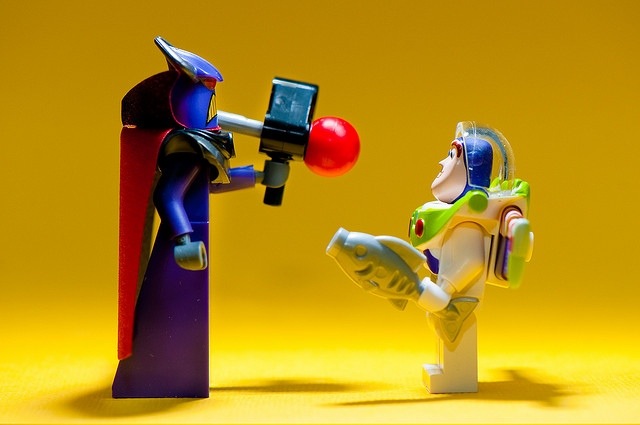The Half-Life of Our Maps
 The early explorers had maps, but they were wrong – sea monsters, missing continents, and the home country at the center. Wrong, yes, but the best maps of their day. The early maps weren’t right because the territory was new, and you can expect the same today. When you work in new territory, your maps are wrong.
The early explorers had maps, but they were wrong – sea monsters, missing continents, and the home country at the center. Wrong, yes, but the best maps of their day. The early maps weren’t right because the territory was new, and you can expect the same today. When you work in new territory, your maps are wrong.
As the explorers’ adventures radiated further from home, they learned and their maps improved. But still, the maps were best close to home and diverged at the fringes. And over the centuries the radius of rightness grew and the maps converged on the territory. And with today’s GPS technology, maps are dead on. The system worked – a complete map of everything.
Today you have your maps of your business environment and the underlying fundementals that ground them. Like the explorers you built them over time and checked them along the way. They’re not perfect (more right close to home) but they’re good. You mapped the rocks, depths, and tides around the trade routes and you stay the course because the routes have delivered profits and they’re safe. You can sail them in your sleep, and sometimes you do.
But there’s a fundamental difference between the explorers’ maps and yours – their territory, the physical territory, never changed, but yours is in constant flux. The business trade winds shift as new technologies develop; the size of continents change as developing countries develop; and new rocks grow from the sea floor as competitors up their game. Just when your maps match the territory, the territory changes around you and diverges from your maps, and your maps become old. The problem is the maps don’t look different. Yes, they’re still the same maps that guided you safely along your journey, but they no longer will keep you safely off the rocks and out of the Doldrums.
But as a new age explorer there’s hope. With a healthy skepticism of your maps, frequently climb the mast and from the crow’s nest scan the horizon for faint signs of trouble. Like a thunder storm just below the horizon, you may not hear trouble coming, but there’ll be dull telltale flashes that flicker in your eyepiece. Not all the crew will see them, or want to see them, or want to believe you saw them, so be prepared when your report goes unheeded and your ship sales into the eye of the storm.
Weak signals are troubling for several reasons. They’re infrequent and unpredictable which makes them hard to chart, and they’re weak so they’re tough to hear and interpret. But worst of all is their growth curve. Weak signals stay weak for a long time until they don’t, and when they grow, they grow quickly. A storm just over the horizon gives weak signals right up until you sail into gale force winds strong enough to capsize the largest ships.
Maps are wrong when the territory is new, and get more right as you learn; but as the territory changes and your learning doesn’t, maps devolve back to their natural wrongness. But, still, they’re helpful. And they’re more helpful when you remember they have a natural half-life.
My grandfather was in the Navy in World War II, though he could never bring himself to talk about it. However, there was one thing he told me, a simple saying he said kept him safe:
Red skies at night, sailor’s delight; red skies in morninng, sailor takes warning.
I think he knew the importance of staying aware of the changing territory.
Top 40 Innovation Bloggers of 2013!
 Top 40 Innovation Bloggers just announced.
Top 40 Innovation Bloggers just announced.
Blown away to be in the top 5! Proud to be part of such an amazing group!
FROM INNOVATION EXCELLENCE — After two weeks of torrid voting and much passionate support, along with a lot of gut-wrenching consideration and jostling during the judging round, I am proud to announce your Top 40 Innovation Bloggers of 2013:
- Jeffrey Baumgartner
 Jeffrey Baumgartner is the author of the book, The Way of the Innovation Master; the author/editor of Report 103, a popular newsletter on creativity and innovation in business. He is currently developing and running workshops around the world on Anticonventional Thinking, a radical new approach to achieving goals through creativity — and an alternative to brainstorming.
Jeffrey Baumgartner is the author of the book, The Way of the Innovation Master; the author/editor of Report 103, a popular newsletter on creativity and innovation in business. He is currently developing and running workshops around the world on Anticonventional Thinking, a radical new approach to achieving goals through creativity — and an alternative to brainstorming.
- Paul Hobcraft
 Paul Hobcraft runs Agility Innovation, an advisory business that stimulates sound innovation practice, researches topics that relate to innovation for the future, as well as aligning innovation to organizations core capabilities.
Paul Hobcraft runs Agility Innovation, an advisory business that stimulates sound innovation practice, researches topics that relate to innovation for the future, as well as aligning innovation to organizations core capabilities.
- Gijs van Wulfen
 Gijs van Wulfen leads ideation processes and is the founder of the FORTH innovation method. He is the author of Creating Innovative Products & Services, published by Gower.
Gijs van Wulfen leads ideation processes and is the founder of the FORTH innovation method. He is the author of Creating Innovative Products & Services, published by Gower.
- Jeffrey Phillips
 Jeffrey Phillips is a senior leader at OVO Innovation. OVO works with large distributed organizations to build innovation teams, processes and capabilities. Jeffrey is the author of Relentless Innovation and the blog Innovate on Purpose.
Jeffrey Phillips is a senior leader at OVO Innovation. OVO works with large distributed organizations to build innovation teams, processes and capabilities. Jeffrey is the author of Relentless Innovation and the blog Innovate on Purpose.
- Mike Shipulski
 Mike Shipulski brings together people, culture, and tools to change engineering behavior. He writes daily on Twitter as @MikeShipulski and weekly on his blog Shipulski On Design.
Mike Shipulski brings together people, culture, and tools to change engineering behavior. He writes daily on Twitter as @MikeShipulski and weekly on his blog Shipulski On Design.
Click here for the whole list.
Decide To Tackle The Impossible
 Doing the impossible doesn’t take a long time, starting does. More precisely, what takes a long time is getting ready to start. Getting ready is the gating item. So what’s in the way?
Doing the impossible doesn’t take a long time, starting does. More precisely, what takes a long time is getting ready to start. Getting ready is the gating item. So what’s in the way?
The big deal about starting is other people will see you do it and they’ll judge you. Your brain tells stories about how people will think you’re silly or incompetent for trying the outrageous. It takes a long time to build the courage to start. But where starting is scary, getting ready is safe and comfortable. Getting ready is done in the head – it’s a private process. And because you do it in your head, you can do it without being judged, and you can do it for as long as you like. And you can take comfort in getting ready because you rationalize you’re advancing the ball with your thinking. (Hey, at least you’re thinking about it.) But the real reason for staying in the getting ready domain is starting the fear around being judged for starting.
After you finally mustered the courage to start, you’ll get welcomed with all sorts of well-intentioned, ill-informed criticism. The first one – We tried that before, and it didn’t work. Thing is, it was so long ago no one remembers what was actually tried. Also, no one remembers how many approaches were tried, and even fewer know why it didn’t work. But, everyone’s adamant it won’t work because it didn’t work. Your response – That was a long time ago, and things have changed since then. There are new technologies to try, new materials that may work, new experimental methods, and new analytical methods to inform the work.
Now that you dismissed the we-already-tried-that’s, the resource police will show up at your door. They’ll say – That’s a huge project and it will consume all our resources. You can’t do that. Your response – Well, I’m not eating the whole enchilada, I only taking the right first bite. And for that, I don’t need any extra resources. You see, my friends and I really want to do this and we pooled our resources and narrowly defined the first bite. So, as far as resources, I’m all set.
Now the alignment officers will find you. They’ll say – Your off-topic mission impossible will confuse and distract our organization and we can’t have that. You know there’s no place for passion and excitement around here. Can you imagine engineers running around doing things that could disrupt our decrepit business model? We’ll no longer have control, and we don’t like that. Please stop. Your response – Let’s set up a meeting with the CEO who’s on the hook to create new businesses, and you can deliver that message face-to-face. You want me to set up the meeting?
Lastly, the don’t-rock-the-boaters will nip at your heels. They’ll say – Things are going pretty well. Did you hear we’re laying off fewer people this quarter? And, we’re losing less money this quarter. Things are looking up. And here you are trying something new, and scaring everyone half to death. You’ve got to stop that nonsense. Your response – Though it may be scary, I have a hunch this crazy stuff could create a whole new business and help secure the company’s future. And I have kids going to college in a couple years, and the company’s future is important to me.
When doing the impossible, the technical part is the easy part. Once you decide to try, what you thought impossible comes quickly. What’s difficult is the people part. Doing the impossible is unpredictable, and it cuts across grain of our culture of predictability. For years it’s been well defined projects with guaranteed profits and completion dates etched in stone. And after years of predictability injections people become the antibodies that reject the very work the company needs – the work that delivers the impossible.
No kidding – once you start the impossible, your organization will make it difficult for you. But, that’s nothing compared to the difficulty of getting ready because in that phase, you must overcome the most powerful, sly, dangerous critic of all – yourself.
Bridging The Chasm Between Technologists and Marketers
 What’s a new market worth without a new technology to capture it? The same as a new technology without a new market – not much. Technology and market are a matched set, but not like peanut butter and jelly, (With enough milk, a peanut butter sandwich isn’t bad.) rather, more like H2 and O: whether it’s H2 without O or O without H2 – there’s no water. With technology and market, there’s no partial credit – there’s nothing without both.
What’s a new market worth without a new technology to capture it? The same as a new technology without a new market – not much. Technology and market are a matched set, but not like peanut butter and jelly, (With enough milk, a peanut butter sandwich isn’t bad.) rather, more like H2 and O: whether it’s H2 without O or O without H2 – there’s no water. With technology and market, there’s no partial credit – there’s nothing without both.
You’d think with such a tight coupling, market and technology would be highly coordinated, but that’s not the case. There’s a deep organizational chasm between them. But worse, each has their own language, tools, and processes. Plain and simple, the two organizations don’t know how to talk to each other, and the result is the wrong technology for the right market (if you’re a marketer) or the right technology for the wrong market (if you’re a technologist.) Both ways, customers suffer and so do business results.
The biggest difference, however, is around customers. Where marketers pull, technologists push – can’t be more different than that. But neither is right, both are. There’s no sense arguing which is more important, which is right, or which worked better last time because you need both. No partial credit.
If you speak only French and have a meeting with someone who speaks only Portuguese, well, that’s like meeting between marketers and technologists. Both are busy as can be, and neither knows what the other is doing. There’s a huge need for translators – marketers that speak technologist and technologists that talk marketing. But how to develop them?
The first step is to develop a common understanding of why. Why do you want to develop the new market? Why hasn’t anyone been able to create the new market? Why can’t we develop a new technology to make it happen? It’s a good start when both sides have a common understanding of the whys.
To transcend the language barrier, don’t use words, use video. To help technologists understand unmet customer needs, show them a video of a real customer in action, a real customer with a real problem. No words, no sales pitch, just show the video. (Put your hand over your mouth if you have to.) Show them how the work is done, and straight away they’ll scurry to the lab and create the right new technologies to help you crack the new market. Technologists don’t believe marketers; technologists believe their own eyes, so let them.
To help marketers understand technology, don’t use words, use live demos. Technologists – set up a live demo to show what the technology can do. Put the marketer in front of the technology and let them drive, but you can’t tell them how to drive. You too must put your hand over your mouth. Let them understand it the way they want to understand it, the way a customer would understand it. They won’t use it the way you think they should, they’ll use it like a customer. Marketers don’t understand technology, they understand their own eyes, so let them.
And after the videos and the live demos, it’s time to agree on a customer surrogate. The customer surrogate usually takes the form of a fully defined test protocol and fully defined test results. And when done well, the surrogate generates test results that correlate with goodness needed to crack the new market. As the surrogate’s test results increase, so does goodness (as the customer defines it.) Instead of using words to agree on what the new technology must do, agreement is grounded in a well defined test protocol and a clear, repeatable set of test results. Everyone can use their eyes to watch the actual hardware being tested and see the actual test results. No words.
To close the loop and determine if everyone is on the same page, ask the marketers and technologist to co-create the marketing brochure for the new product. Since the brochure is written for the customer, it forces the team use plain language which can be understood by all. No marketing jargon or engineering speak – just plain language.
And now, with the marketing brochure written, it’s time to start creating the right new market and the right new technology.
Photo credit – TORLEY.
Breaching the Wall of Denial

To do innovation, you’ve got to be all in, both physically and mentally. And to be all in, you’ve got to bust through one of the most powerful forces on the planet – denial.
Denial exists because seeing things as they are is scary. Denial prevents you from seeing problems so you can protect yourself from things that are scary. But the dark consequence of its protection is you block yourself from doing new things, from doing innovation. Because you deny the truth of how things are, you don’t acknowledge problems; and because you don’t admit there’s a problem, there’s no forcing function for doing the difficult work of innovation.
Problems threaten, but problems have power. Effectively harnessed, problems can be powerful enough to bust through denial. But before you can grab them by the mane, you have to be emotionally strong enough to see them. You have to be ready to see them; you have to be in the right mindset to see them; and because your organization will try to tear you down when you point to a big problem, you have to have a high self worth to stand tall.
Starting an innovation project is the toughest part and most important part. Starting is the most important because 100% of all innovations projects that don’t start, fail. Those aren’t good odds. And because starting is so emotionally difficult, people with high self worth are vital. Plain and simple: they’re strong enough to start.
Denial helps you stay in your comfort zone, but that’s precisely where you don’t want to be. To change and grow you’ve got to breach the wall of denial, and climb out of your comfort zone.
The Parent of Learning
 Hypothesis is a charged word – It has a scientific color; it smacks of sterility; it is thought to be done by academics; and it’s sometimes classified as special class of guessing. In thought and action, hypothesis is misunderstood.
Hypothesis is a charged word – It has a scientific color; it smacks of sterility; it is thought to be done by academics; and it’s sometimes classified as special class of guessing. In thought and action, hypothesis is misunderstood.
We twist the word so it doesn’t apply in our situation; we label it to distance ourselves; we tag it with snarl connotations to protect ourselves. We do this because we’re afraid of the word’s power.
Replace hypothesis with “I think this will happen – [fill in the blank.]” and it’s clear why we’re afraid. Hypothesis, as an activity, has the power to make it clear to everyone that you really don’t know what’s going on. Hypothesis demands you speculate based on your knowledge, and the fear is when you’re wrong (and you will be) people will think your knowledge (and you) is of a meager kind. Hypothesis demands you put yourself out there for the world to see. And that’s why it’s rarely done. And since it’s rarely done, its benefits are not understood.
Innovation is all the rage these days, and innovation is all about learning. And where necessity is the mother of invention, hypothesis is the father of learning. Hypothesis breeds learning by providing a comparison between what you thought would happen and what happened. The difference is a measure of your knowledge; and how the difference changes over time is a measure of your learning. If the difference widens over time, you’re getting cold; if it stays constant, you’re treading water; and if it converges, you’re learning.
Like a good parent, hypothesis knows which rules can be bent and which won’t be compromised. In the hypothesis household clarity and honesty are not optional – clarity around the problem at hand; clarity around how you’ll test and measure; and honesty around the limits of your knowledge.
Learning is important – no one can argue – and learning starts with a hypothesis. More strongly, learning is so important you should work through your fear around hypothesis and increase your learning rate.
Really, hypothesis isn’t the stern parent you think. Hypothesis will make time to teach you to ride your bike without training wheels, and be right there to bandage your skinned knees.
And, like a good parent, if you ask hypothesis for help, I think this will happen – [you’ll learn more and learn faster.]
Letting Go Of Last Year
Last year is gone, and going forward things will be different. Last year’s you is gone, and going forward you will be different. That’s the thing – everything changes. Regardless if last year was enjoyable or terrible, no matter. This year will be different. You can try to hold on to it, but all you’ll get is rope burns. Or, you can take comfort in the impermanence.
Your company is different; your competitors are different; your customers are different. In fact, everything is different. And what you did last year won’t get the same response today. Yet we hold on. It’s difficult to see things as they are when there’s so much comfort in seeing things as they were. Even if things weren’t so good last year, there’s comfort in seeing things as they were.
Toughest of all is to see yourself as you are. (I’m not talking about the body stuff – older, grayer, more wrinkles – that’s easy to see. I’m talking about the inside stuff.) On the inside, you are not what you were last year. You don’t have to know how you are different; just take comfort that you are different. Take comfort that right here, right now, as you sit, you are different, and so is everything else.
It’s difficult to plan out how things will go this year; and it’s impossible to predict how you’ll grow. Things will change; you will change; and putting yourself in that frame of mind can be helpful.
At the New Year, take time to celebrate the upcoming impermanence that will surely find you.
Photo from free HDR Photos – www.freestock.ca
Gifts Are For The Giver
 I’ve read emails from engineering students telling me I whipped them into a fervor over engineering.
I’ve read emails from engineering students telling me I whipped them into a fervor over engineering.
I’ve received notes from engineering leaders that, based on a single line of a post, reinvented the cost signature of their products.
I’ve been sent messages from folks who were stuck in a rut, and after reading my post, were able to work through their self-imposed constraints.
My inbox has let me know a reader, after thinking about my thinking, tried something that truly scared them.
They all thanked me for what I gave them, but, really, I want to thank them for what they gave me.
They listened; they thought; they changed their behavior. There can be no bigger gift.
I know not everyone celebrates my holiday, but, nonetheless, I want to share it with you.
Merry Christmas, and thanks for your gifts.
Weak Signals And The Radical Fringe
We strive to get everyone on the same page, to align the crew in a shared direction. The thinking goes – If we’re all pulling in the same direction, we’ll get there faster and more efficiently. Yes, the destination will come sooner, but what if it’s not there when we get there?
There’s implicit permanence to our go-forward travel plans. We look out three years and plan our destination as if today’s rules and fundamentals will still apply. We think – That imaginary tropical vacation spot will be beautiful in three years because it looks beautiful through the kalidascope of today’s success. But as the recent natural disasters have taught us, whole islands can be destroyed in an instant. But still, the impermenance of today’s tried-and-true business models is lost on us, and we see the unknowable future as statically as the unchangeable map of the continents.
Thing is, all around us there are weak indications the fundamental tradewinds have started to shift – weak signals of impermenance that may invalidate today’s course heading. But weak signals are difficult to hear – the white noise of yesterday’s success drowns out the forward-looking weak signals. And more problematic, once heard, weak signals are easily dismissed because their song threatens the successful status quo.
You feel weak signals in your chest. It could be a weak signal when your experience tells you things should go one way and they actually go another. Martin Zwilling (Forbes) has some great examples. (Thanks to Deb Mills-Scofield [@dscofield] for retweeting the article.)
100% alignment reduces adaptability because it deadens us to weak signals, and that’s a problem in these times of great impermanence. To counter the negative elements of alignment, there must be a balancing injection of healthy misalignment. This is an important and thankless task falls on the shoulders of a special breed – the radical fringe. They’re the folks smart enough to knit disjointed whispers into coherent ideas that could unravel everything and brave enough to test them.
Disruptive movements and revolutions build momentum quietly and slowly. But if you can recognize them early, there’s a chance you can get into position to ride their tsunami instead of being ambushed and scuttled by it. But you’ve got to listen closely because these young movements are stealthy and all they leave in their wake are weak signals.
Tracking Toward The Future
 It’s difficult to do something for the first time. Whether it’s a new approach, a new technology, or a new campaign, the mass of the past pulls our behavior back toward itself. And sadly, whether the past has been successful or not, its mass, and therefore it’s pull, are about the same. The past keeps us along the track of sameness.
It’s difficult to do something for the first time. Whether it’s a new approach, a new technology, or a new campaign, the mass of the past pulls our behavior back toward itself. And sadly, whether the past has been successful or not, its mass, and therefore it’s pull, are about the same. The past keeps us along the track of sameness.
Trains have tracks to enable them to move efficiently (cost per mile), and when you want to go where the train is heading, it’s all good. But when the tracks are going to the wrong destination, all that efficiency comes at the expense of effectiveness. Like we’re on rails, company history keeps us on track, even if it’s time for a new direction.
The best trains run on a ritualistic schedule. People queue up at same time every morning to meet their same predictable behemoth, and take comfort in slinking into their regular seats and turning off their brains. And this is the train’s trick. It uses its regularity to lull riders into a hazy state of non-thinking – get on, sit down, and I’ll get your there – to blind passengers from seeing its highly limited timetable and its extreme inflexibility. The train doesn’t want us to recognize that it’s not really about where the train wants to go.
Trains are powerful in their own right, but their real muscle comes from the immense sunk cost of their infrastructure. Previous generations invested billions in train stations, repair facilities, tight integration with bus lines, and the tracks, and it takes extreme strength of character to propose a new direction that doesn’t make use of the old, tired infrastructure that’s already paid for. Any new direction that requires a whole new infrastructure is a tough sell, and that’s why the best new directions transcend infrastructure altogether. But for those new directions that require new infrastructure, the only way to go is a modular approach that takes the right size bites.
Our worn tracks were laid in a bygone era, and the important destinations of yesteryear are no longer relevant. It’s no longer viable to go where the train wants; we must go where we want.
It Can’t Be Innovation If…
Companies strive for predictability, yet if it’s predictable, it cannot be innovation.
We seek comfort in our work, but if it’s comfortable it can’t be innovation.
Businesses like to grow by selling more to the customers we have, but if existing customers can recognize it, it can’t be innovation.
We want to meet year end numbers, but if the project will generate profit in the year it begins, it can’t be innovation.
We love our standardized processes, but if it’s standard, it cannot be innovation.
If there’s consensus, it’s not innovation.
If the project isn’t wreaking havoc with your organizational norms, it can’t be innovation.
If the market already exists, it can’t be innovation.
If you’ve done it before, it can’t be innovation.
If you are following a best practice, it can’t be innovation.
If there’s a high probability it will work, it can’t be innovation.
If people aren’t threatened, it can’t be innovation.



 Mike Shipulski
Mike Shipulski